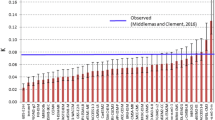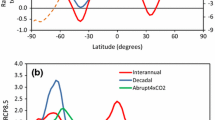Abstract.
A comparison is performed for water vapour, cloud, albedo and lapse rate feedbacks taken from published results of 'offline' feedback calculations for general circulation models (GCMs) with mixed layer oceans performing 2 × CO2 and solar perturbation experiments. All feedbacks show substantial inter-model spread. The impact of uncertainties in feedbacks on climate sensitivity is discussed. A negative correlation is found between water vapour and lapse rate feedbacks, and also between longwave and shortwave components of the cloud feedback. The mean values of the feedbacks are compared with results derived from model intercomparisons which evaluated cloud forcing derived feedbacks under idealized climate forcing. Results are found to be comparable between the two approaches, after allowing for differences in experimental technique and diagnostic method. Recommendations are made for the future reporting of climate feedbacks.




Similar content being viewed by others
References
Arking A (1991) The radiative effects of clouds and their impact on climate. Bull Am Meteorol Soc 71: 795–813
Cess RD, Potter GL, Blanchet JP, Boer GJ, Ghan SJ, Hansen J, Kiehl JT, Le Treut H, Li Z-X, Liang X-Z, McAvaney BJ, Meleshko VP, Mitchell JFB, Morcrette J-J, Randall DA, Rikus LJ, Roeckner E, Schlese U, Sheinin DA, Slingo A, Sokolov AP, Taylor KE, Washington WM, Wetherald RT, Yagaii I (1990) Intercomparison and interpretation of cloud-climate feedback processes in nineteen atmospheric general circulation models. J Geophys Res 95: 16,601–16,615
Cess RD, Potter GL, Blanchet JP, Boer GJ, Colman R, Ghan SJ, Hansen J, Kiehl JT, Le Treut H, Li Z-X, Liang X-Z, McAvaney BJ, Meleshko VP, Mitchell JFB, Morcrette J-J, Randall DA, Rikus LJ, Roeckner E, Schlese U, Sheinin DA, Slingo A, Sokolov AP, Taylor KE, Washington WM, Wetherald RT, Yagaii I (1991) Intercomparison and interpretation of snow-climate feedback processes in seventeen atmospheric general circulation models. Science 253: 888–892
Cess RD, Zhang MH, Potter GL, Alekseev V, Barker HW, Cohen-Solal E, Colman RA, Dazlich DA, Del Genio AD, Dix MR, Dymnikov V, Esch M, Fowler LD, Fraser JR, Galin V, Gates WL, Hack JJ, Kiehl JT, Le Treut H, Lo KW, McAvaney BJ, Meleshko VP, Morcrette JJ, Randall DA, Roeckner E, Royer J-F, Schlesinger ME, Sporyshev PV, Taylor KE, Timbal B, Volodin EM, Wang W, Wetherald RT (1996) Cloud feedback in atmospheric general circulation models: an update. J Geophys Res 101: 12,791–12,794
Colman RA (2001) On the vertical extent of atmospheric feedbacks. Clim Dyn 17: 391–405
Colman RA, McAvaney BJ (1997) A study of GCM climate feedbacks from perturbed SST experiments. J Geophys Res 102: 19,383–19,402
Colman RA, Power SB, McAvaney BJ (1997) Non-linear climate feedback analysis in an atmospheric GCM. Clim Dyn 13: 717–731
Colman RA, Fraser JR, Rotstayn LD (2001) Climate feedbacks in a general circulation model incorporating prognostic clouds. Clim Dyn 18: 103–122
Gong W, Zhou X, Wang W-C (1994) A diagnostic study of feedback mechanisms in greenhouse effects simulated by NCAR CCM1. Acta Meteorol Sinica 8: 270–282
Hansen J, Johnson D, Lacis A, Lebedeff S, Lee P, Rind D, Russell G (1981) Climate impacts of increasing carbon dioxide. Science 213: 957–966
Hansen J, Lacis A, Rind D, Russell G, Stone P, Fung I, Ruedy R, Lerner J (1984) Climate sensitivity: analysis of feedback mechanisms. In: Hansen JE, Takahashi T (eds) Climate processes and climate sensitivity, American Geophysical Union, Washington DC, USA, pp 130–163
Hansen J, Sato M, Reudy R (1997) Radiative forcing and climate response. J Geophys Res 102: 6831–6864
Held IM, Soden BJ (2000) Water vapour feedback and global warming. Annu Rev Energy Environ 25: 441–475
Ingram WJ, Wilson CA, Mitchell JFB (1989) Modelling climate change: an assessment of sea ice and surface albedo feedbacks. J Geophys Res 94: 8609–8622
IPCC (1996) Climate change 1995, the science of climate change. Houghton JT, Meira Filho LG, Callander BA, Harris N, Kattenberg A, Maskell K (eds) Cambridge University Press, Cambridge, UK, pp 572
IPCC (2001) Climate change 2001: the scientific basis. Houghton JT, Ding Y, Griggs DJ, Noguer M, van der Linden PJ, Dai X, Maskell K, Johnson CA (eds) Cambridge University Press, Cambridge, UK, pp 881
Le Treut H, Li ZX, Forichon M (1994) Sensitivity study of the LMD GCM to greenhouse forcing associated with two different cloud water parametrizations. J Clim 7: 1827–1841
McAvaney BJ, Colman RA (1996) Water vapor and cloud feedbacks in the BMRC GCM. In: Le Treut H (ed) Climate sensitivity to radiative perturbations physical mechanisms and their validation. NATO ASI vol I 34, Springer, Berlin Heidelberg New York, pp 171–190
Mitchell JFB, Ingram WJ (1992) Carbon dioxide and climate: mechanisms of changes in cloud. J Clim 5: 5–21
Roeckner E, Schlese U, Biercamp J, Loewe P (1987) Cloud optical depth feedbacks and climate modelling. Nature 329: 138–140
Schlesinger ME (1988) Quantitative analysis of feedbacks in climate model simulations of CO2 induced warming. In: Schlesinger ME (ed) Physically based modelling and simulation of climate and climate change. NATO ASI Series C, vol 243 Kluwer Academic, Dordrecht, Netherlands
Schneider EK, Kirtman BP, Lindzen RS (1999) Tropospheric water vapor and climate sensitivity. J Atmos Sci 56: 1649–1658
Senior CA, Mitchell JFB (1993) Carbon dioxide and climate: the impact of cloud paramatrization. J Clim 6: 393–418
Taylor KE, Ghan SJ (1992) An analysis of cloud liquid water feedback and global climate sensitivity in a general circulation model. J Clim 5: 907–919
Watterson IG, Dix MR, Colman RA (1999) A comparison of present and doubled CO2 climates and feedbacks simulated by three GCMs. J Geophys Res 104: 1943–1956
Wetherald RT (1996) Feedback processes in the GFDL R30-14 level general circulation model. In: Le Treut H (ed) Climate sensitivity to radiative perturbations physical mechanisms and their validation. NATO ASI vol I 34, Springer, Berlin Heidelberg New York, pp 251–267
Wetherald RT, Manabe S (1988) Cloud feedback processes in a GCM. J Atmos Sci 45: 1397–1415
Yao M-S, Del Genio AD (1999) Effects of cloud parametization on the simulation of climate changes in the GISS GCM. J Clim 12: 761–779
Zhang MH, Cess RD, Hack JJ, Kiehl JT (1994) Diagnostic study of climate feedback processes in atmospheric general circulation models. J Geophys Res 99: 5525–5537
Zhang MH, Kiehl JT, Hack JJ (1996) Cloud-radiative feedback as produced by different parametrizations of cloud emissivity in CCM2. In: Le Treut H (ed) Climate sensitivity to radiative perturbations: physical mechanisms and their validation. NATO ASI, Ser. I, vol 34, Springer, Berlin Heidelberg, New York, pp 213–230
Acknowledgements.
The author wishes to thank Martin Dix, Bryant McAvaney and two anonymous reviewers for helpful comments, and Martin Dix for supplying unpublished CSIRO feedback results. This work was supported by the Australian Greenhouse Office.
Author information
Authors and Affiliations
Corresponding author
Appendix 1: Estimation of the lapse rate feedback
Appendix 1: Estimation of the lapse rate feedback
1.1 Lapse rate feedback reported, but without an equilibrated stratosphere (GFDL1, 2, BMRC1, CSIRO): Method 1 (following Arking 1991)
All four models also quote instantaneous TOA CO2 forcing, \( \delta R_{CO_2 } \) (which includes both LW and SW forcing), and surface temperature feedback: \( {\partial R_{T_\ast} \over \partial T_\ast}. \)
Assuming the CO2 forcing produces a warming of ΔT 0, with only the surface temperature feedback operating, then:
where s is the radiative response due to stratospheric cooling. The value of s can then be subtracted from the quoted lapse rate feedback, giving \( {\partial R_\Gamma \over \partial T} \) as a residual. Assuming ΔT 0 = 1.2 K (Hansen et al. 1984), values of the stratospheric cooling response for the models vary from 1.5 to 1.8 Wm–2 (c.f. Hansen et al. 1997, value of 1.6 Wm–2).
Based on this range, uncertainty in the final feedback may be roughly ±0.1 Wm–2 K–1.
1.2 No lapse rate feedback reported, (although total temperature feedback known) (UKMO, MPI): Method 2
Total temperature feedback is assumed to be the sum of surface temperature (T *) and lapse rate (Γ) feedbacks plus the effect of stratospheric temperature change (s). The latter (properly regarded as an adjustment, not a feedback) is assumed to be 1.6 Wm–2 for CO2 forcing (taken from Hansen et al. 1997, and supported by method 1 calculations). For +2% solar forcing, s is taken as –0.19 Wm–2 (Hansen et al. 1997). The surface temperature feedback is taken from the mean of the seven models which reported it (BMRC1, 2, GFDL1, 2, GISS1, 2 and CSIRO). The mean value of these is –3.34 Wm–2 K–1 with a standard deviation of 0.1 Wm–2 K–1 and a range of 0.32 Wm–2 K–1. Lapse rate feedback is then calculated as a residual.
Noting the range of these values and the uncertainty in s, uncertainty in the final lapse rate feedback is estimated at approximately ±0.15 Wm–2 K–1.
1.3 No temperature feedback reported (LMD1,2): Method 3
The sum of all feedbacks, \( \sum\limits_i {{\partial R_i \over \partial T_\ast},} \) can be calculated from Eq. 2 (following Schlesinger 1988), where ΔT 0 is the temperature change with only surface temperature responses,ΔT * is the final surface temperature change, and \( K = \left( {{{\partial R_{T_* } } \over {\partial T_* }}} \right)^{ - 1} . \)
Assuming ΔT 0 =1.2 (Hansen et al. 1984) and taking K = 0.3 Km2W–1 from quoted model results, noted in the discussion of method 2, permits calculation of \( \sum\limits_i {{\partial R_i \over \partial T_\ast}. } \) Knowing all other feedbacks, permits lapse rate feedback to be calculated as a residual.
Some measure of the potential error associated with this method may be obtained by calculating the lapse rate feedback for these models where it is reported with an equilibrated stratosphere (BMRC2, CCM1). The errors here are 0.06 and 0.01 Wm–2 K–1 respectively. Errors for the GISS1 and 2 models are close to zero, as these values are those used to specify the method. Errors in the remaining models (Table 3) are more difficult to estimate as the true value of the lapse rate feedback is not known, but disagreement with method 1 is as large as 0.2 Wm–2 K–1 (BMRC1), and with method 2 of 0.5 Wm–2 K–1 (MPI).
From Table 3, and from the results of the BMRC2 and CCM1 an error of ±0.3 Wm–2 K–1 is used in Fig. 2. Given the larger error associated with this method, method 1 and 2 values, where available, are used in Fig. 2.
Rights and permissions
About this article
Cite this article
Colman, R. A comparison of climate feedbacks in general circulation models. Climate Dynamics 20, 865–873 (2003). https://doi.org/10.1007/s00382-003-0310-z
Received:
Accepted:
Published:
Issue Date:
DOI: https://doi.org/10.1007/s00382-003-0310-z




